Abstract
Asphalt binders in pavements lose their stability through aging and eventually fail in the field. Using nuclear magnetic resonance (NMR) to monitor the primary longitudinal relaxation time of asphalt samples and the ratio of material that carries this primary relaxation time has been shown to indicate the impact of ultraviolet (UV) radiation on the aging of asphalt pavements. Longitudinal NMR relaxation was used to investigate two types of proposed asphalt rejuvenators, a bio-oil-based rejuvenator and a crude-oil-based rejuvenator. Two different binders with the performance grades (PG) 64-22 and 76-22 were considered for their interactions with the rejuvenators. After 72 h of exposure to intense UV radiation, specifically designed NMR relaxometry experiments were applied to compare the rejuvenation capabilities of the two rejuvenator samples. The crude oil-based rejuvenator was found to exhibit relaxation times similar to the binder samples while the bio-based material showed relaxation times that pointed to different nuclear hydrogen environments. Both rejuvenators reduced the primary relaxation time of the PG 76-22 binder, which indicates that their stiffness was reduced. Both types of rejuvenators also seemed to prevent the effects of UV aging. Two mechanisms of rejuvenation were identified by NMR relaxometry. The primary relaxation time can be used to indicate a change in stiffness while the primary ratio of the material is tied to oxidative aging. Oxidative aging creates distinct hydrogen environments due to asphaltene aggregation. The bio-based rejuvenator only reduced the binder’s stiffness, while the crude oil-based rejuvenator also reduced the aggregation of asphaltenes. Consequently, the bio-based rejuvenator could be classified as an asphalt softener, while the oil-based material acted like a true rejuvenator.
1. Introduction
Asphalt is globally used as a large part of transportation infrastructure [1,2,3,4]. There are three main ways that asphalt ages: heating and compaction in the construction phase, load damage and erosion caused by traffic, and environmental effects such as ultraviolet (UV) radiation and moisture [3,4,5,6,7,8,9,10,11]. Aging manifests itself in many ways, and all of them eventually lead to failures. After enough failures have accrued, asphalt surfaces are either repaired with more material or discarded and rebuilt. Discarded pavements occupy a large amount of space [1,2,12,13,14,15,16]. Recycling asphalt pavement is an effective way to minimize the use of binder and the space consumed by waste, improving the environmental impacts of asphalt pavements. Additionally, prolonging service life is another solution to increase the road pavement’s lifespan and decrease the necessity for repair.
Currently, the most promising way to accomplish either solution is using rejuvenators to restore or enhance an aged binder’s properties to a more virgin state [1,5,6,13,14]. However, the mechanics of rejuvenation are still not fully known due to the complexity of interaction mechanisms and the variability of asphalt binders and potential rejuvenators [7,12,17,18,19,20]. General qualities of effective rejuvenators have been found through phenomenological and methodic approaches, with the redistribution of asphaltenes within the maltene phase being the most prevalent reasoning [6,7,14]. The method of rejuvenator application is another researched topic. Commercially, rejuvenators are either applied by sprayers or fog sealing soon after mixing and compaction to elongate the service life of the asphalt pavement [21,22] or on a schedule to prevent surface deterioration [22,23]. Alternatively, rejuvenators are applied to recycled binder mixtures to restore the chemical and physical properties to a more virgin state [24,25]. Research has mainly focused on this last method, but the type of rejuvenators and softening agents used varies greatly [2,4,5,6,7,8,10,11,12,13,14,15,17,18,19,20,25,26,27,28,29,30,31,32,33,34,35,36]. Many materials are oil based and rely on maltene replacement, while other materials are found to just reduce the viscosity of the material. While reducing the viscosity/stiffness of an aged material is important, it should not be the only factor to consider in the rejuvenation mechanism.
Adding to the complexity of rejuvenation is the classification of asphalt softeners as rejuvenators and the interchangeable use these terms have had [2,8,31]. The most important distinction between rejuvenators and softening agents is the effect they have on restoring the properties of the asphalt binder [8]. Softeners are not meant to restore the chemical and physical properties of a binder to a virgin state, but to decrease the PG grading of a stiffer binder [26]. Among other methods, dynamic shear rheometer (DSR) [4,6,7,17,20,28,30,31,32,33,37,38,39,40], atomic force microscopy (AFM) [4,5,17,28], nuclear magnetic resonance (NMR) [14,32,33,37,40,41], Fourier-transform infrared (FTIR) [4,5,10,15,20,32,33,34,36,37,39,40], and saturate aromatic resin asphaltene (SARA) [5,17,34] analyses have been used with varying success to try to characterize and evaluate the effects of asphalt rejuvenation.
In this study, T1 NMR relaxometry is used to evaluate the chemical differences between rejuvenation and softening. A true rejuvenator will return or maintain the favorable properties of an unaged material. Commercial crude oil and bio oil-based rejuvenators will be compared. These commercial rejuvenators are specified to be placed before major aging occurs. Photo-oxidation from UV radiation is a known cause of aging and has been detected by NMR relaxometry [40]. Asphalt binders have been shown to have unique T1 relaxation times and through measuring the lattice–spin relaxation, distinct environments can be shown. Additionally, comparisons of relaxation time to stiffness have been drawn [37,40,41]. Therefore, UV aging will be used to age the sample to determine the preventative qualities of both rejuvenators. The traditional rejuvenation detected as a change in viscosity will be determined with a higher-performance-grade binder. Because of this, NMR relaxometry is a method superior to physical testing and compositional/functional group analysis for determining the effectiveness of rejuvenators.
2. Materials and Methods
The asphalt binders used in this study PG 64-22 and PG 76-22 binders were sourced from Philip 66 Granite City, IL, USA. The rejuvenators were received by corporate sponsors and are listed as Rej. B and Rej. C. Rej. B is a soybean oil-based commercial topical rejuvenator, while Rej. C is a crude oil-based topical rejuvenator. Samples were prepared by dipping a 2 mm capillary tube into a heated binder to provide a consistent sample layer. After the binder cooled, the capillary tube was submerged in the rejuvenator for 5 s. Afterward, the capillary tube was placed in a fume hood for 24 h of interaction time before being placed in a 5 mm NMR tube for testing. Ultraviolet (UV) radiation aging was conducted by placing the NMR sample tube into a homemade UV apparatus for 72 h at the lowest rotation setting. The radiation time of 72 h has previously been used as a standard [40]. It also ensures enough time for significant interactions to be observed [42]. The UV apparatus comprises a UV lamp with a 390–400 nm. bulb, a Büchi Rotovapor R 110, and reflective foil. To test the pure oil, rejuvenators were prepared by drying them for one week in a fume hood to remove excess water before then filling a 5 mm NMR tube with the remnants.
A Bruker Advance DRX 200-MHz spectrometer was used to acquire the 1H NMR T1 relaxation spectra. NMR spin–lattice relaxation data were recorded with the SIP-R method [43]. 256 1H SIP-R spectra of four scans each were collected. A five-second pre-delay was used to allow for nuclear magnetization to return to thermodynamic equilibrium before each scan. The d7 range varied depending on the rejuvenator used, but all samples started at 0.015 milliseconds and proceeded until complete relaxation, which occurred between 10 and 15 s. The results from the spectra were analyzed through SigmaPlot’s mono-, bi-, and tri-exponential decay regressions, as well as through an inverse Laplace transform (ILT) with T1 times spaced equidistantly on a log scale to allow for the sample to fully relax. A summary of the multi-material testing methodology is shown in Figure 1. In addition to this, each binder and rejuvenator was tested individually.
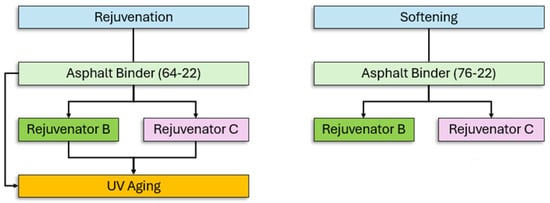
Figure 1.
Methodology of testing rejuvenation and softening.
Both rejuvenators were set out to evaporate off the water before testing. The remaining oil was then tested. The bio oil-based rejuvenator (Rej B) contained at least three major relaxation times as shown in Table 1. Since this material was not crude oil based, the relaxation times did not align with the normally expected relaxation times of asphalt binder, around 0.47 and 0.002 s. Alternatively, the crude oil-based rejuvenator (Rej C) contained only two hydrogen environments. Rej C more closely matched the expected primary and secondary relaxation times of the PG 64-22 and 76-22 binders, as shown in Table 1. The PG 76-22 was a stiffer grade of binder, which was reflected by the increased primary relaxation time of 0.51s. The primary relaxation time was determined by the largest corresponding ratio. Since most of the materials had fewer than three relaxation times, only monoexponential and biexponential fits were considered.

Table 1.
Relaxation times of rejuvenators and binders.
Equation (1) describes the ratio used, where and are the intensities related to the two relaxation times , and . The Herbaw Parameter (The Herbaw Parameter (Hb) was named in honor of the scientists and engineers who developed it: Herndon, Balasubramanian, and Woelk) is the product of the inverse ratio and the relaxation time of the highest intensity peak. These equations give information on the hydrogen environments formed in samples (including if any new ones are formed) and an indication of stiffness.
3. Results
3.1. Binder
Asphalt binder has characteristic relaxation times, as detected by NMR. Table 2 displays the primary and secondary relaxation times of a PG 64-22 and 76-22 asphalt binder. The major difference between these grades was the viscoelastic stiffness, which is represented by the primary relaxation time. The secondary relation time did not change significantly in intensity or ratio. The primary relaxation time was shown to increase, which confirmed the relation between primary relaxation time and binder stiffness [37].

Table 2.
Binder grade comparison.
If aging occurs, usually the secondary relaxation time changes, as displayed in Table 2. UV radiation has been shown to increase binder stiffness through oxidation [40]. This is further detected by NMR relaxometry as an increase in the secondary ratio, which also reduces the primary ratio. The primary ratio decreases, since more distinct hydrogen environments are forming, increasing the stiffness of the material. These additional hydrogen environments were considered to be formed from oxidative aging due to the aggregation of asphaltenes. This detection method by NMR relaxometry suggested that only the UV-aged sample had a considerable amount of asphaltene aggregation due to the large reduction of the primary T1 ratio.
3.2. Rejuvenation-Softening
Usually, rejuvenators are used to reduce the stiffness/performance grade of an aged material. The primary relaxation time can be used for comparison of stiffness as displayed in Figure 2. Both rejuvenators reduced the primary relaxation time, reflecting the softening effects of adding a lower-viscosity material to the asphalt binder. Alternatively, the primary ratio did not relate as well. The primary ratio decreased due to additional hydrogen environments forming from the rejuvenator as shown in Table 3. The relaxation time that indicated oxidative aging was around 0.002 s, and other environments may be formed due to the rejuvenators, not oxidative aging. Since there is no large aggregation of asphaltenes already present in the PG 76-22 due to the high primary ratio (0.92), the reduction of aggregation cannot be determined, only the softening effects of the rejuvenators. The reduction of the T1 ratio was attributed to additional hydrogen environments from the rejuvenators. While the relaxation times of the bio-based material were consistent with the PG 76-22, the crude oil-based rejuvenator introduced another, faster relaxation time. This extra hydrogen environment is most likely an interaction of the oil with the binder. The higher ratio of the 0.002 s relaxation time due to the addition of Rej B could indicate that oxygen-containing compounds were already present in the rejuvenator.
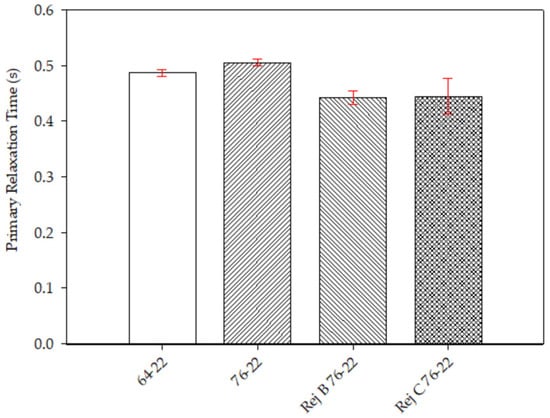
Figure 2.
PG 76-22 coated with rejuvenators and compared with primary T1 times from a bi-exponential fit.

Table 3.
PG 76-22 coated with rejuvenators.
3.3. Rejuvenation-Prevention
Similar to the PG 76-22, when the rejuvenators were added to the PG 64-22 asphalt binder, the primary relaxation time was reduced as seen in Figure 3a. This reduction in the primary relaxation time has been related to a change in the stiffness of the material, as discussed with the PG 76-22 interaction. Also, as seen with the 76-22 interaction, the primary ratio decreased due to distinct hydrogen environments caused by the rejuvenators as seen in Figure 3b. Figure 3c compares the Herbaw Parameter of each sample. Since no oxidative aging has occurred, this parameter was not as effective to use for a meaningful comparison. Other hydrogen environments were formed that were not found in the binder or the rejuvenator as shown in Table 4. The bio-based rejuvenator may only have 2 relaxation times while the crude-based rejuvenator formed an additional environment at a faster relaxation time. This faster relaxation time interaction was also seen with the PG 76-22 and Rej C interaction sample and had an even faster relaxation time of around 0.00004 s. Samples with three or more relaxation times require further analysis.
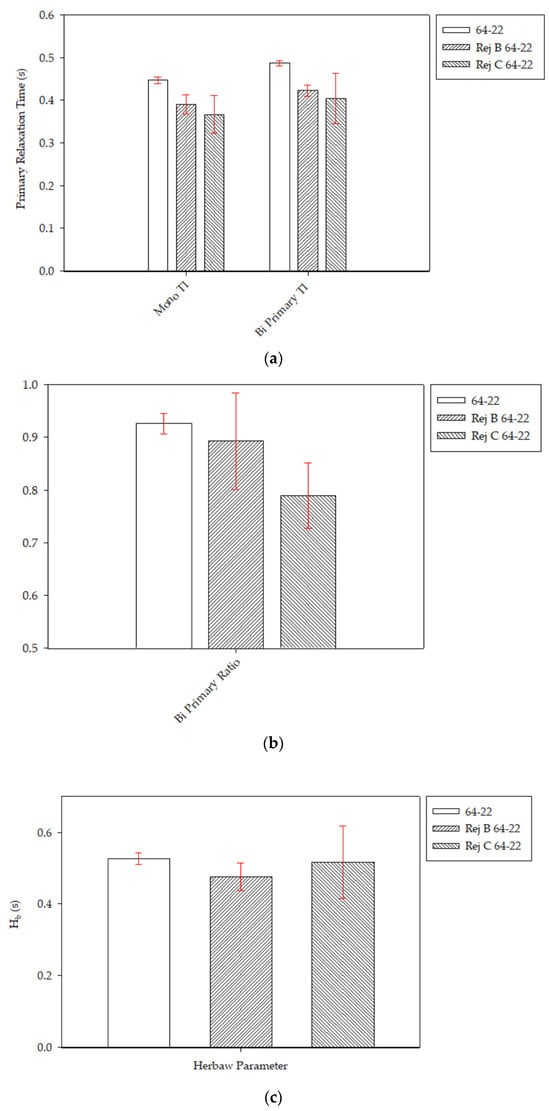
Figure 3.
PG 64-22 coated with rejuvenators analyzed by (a) primary relaxation time, (b) Bi primary ratio, and (c) Herbaw Parameter.

Table 4.
PG 64-22 binder coated with rejuvenators.
After the blends were set out for 24 h, the samples were UV-aged for 72 h. In most samples, the shorter relaxation ratio, with a relaxation time between 0.001 and 0.009 s, increased after UV radiation due to oxidative aging causing the aggregation of asphaltenes, as shown in Table 5. In other words, the primary ratio decreased. However, the primary ratio did not decrease for the sample that applied Rej C before UV aging. The 64-22 UV72 Rej B sample showed a reduction in the primary relaxation time and primary ratio as shown in Figure 4a,b. The 64-22 UV 72 Rej C sample had a slight increase in primary relaxation time but kept the primary ratio at unaged conditions, as seen in Figure 4b. The bio-based rejuvenator kept the binder below unaged conditions. While the binder may have been softer, the asphalt matrix did not maintain its relaxation ratio. Alternatively, the crude oil-based material was shown to slightly increase the stiffness, but reduce the aggregation of asphaltenes, reducing the impact of oxidative aging. The primary relaxation time and primary ratio can be summarized as the Herbaw Parameter. Considering both, when Rej C was added, the unaged conditions were maintained as shown in Figure 4c. Alternatively, Rej B did not maintain unaged conditions.

Table 5.
UV comparison of the bio-based oil.
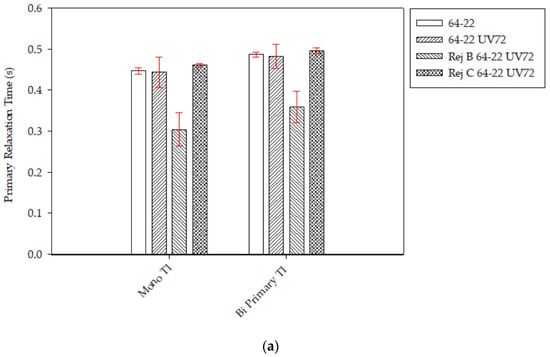
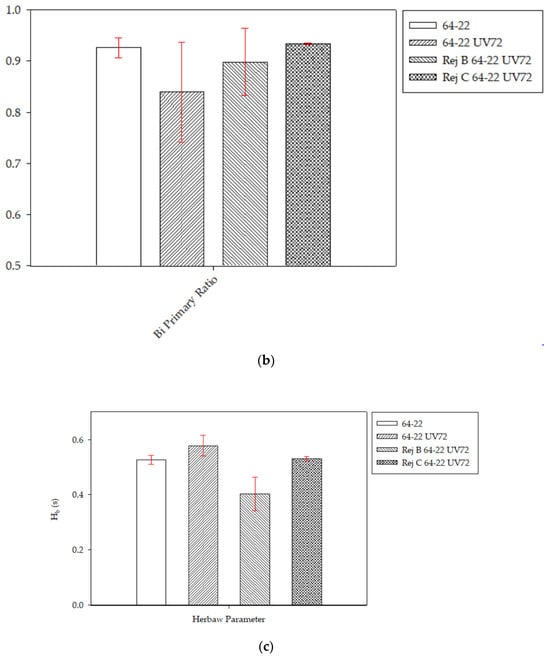
Figure 4.
UV aging comparison of rejuvenators analyzed by (a) primary relaxation time, (b) Bi primary ratio, and (c) Herbaw Parameter.
4. Discussion
Asphalt binder fails over time due to many factors. Asphalt binders are classified by performance grades (PG) which rely on the binder’s stiffness. Rejuvenators can be added before or after the binder is aged to maintain or return the material properties to an unaged or favorable PG condition. Rejuvenation is usually seen as a change in the binder’s PG or stiffness, but there are other effects to consider. Environmental aging conditions on the pavement’s surface may not always lead to a change in binder PG, but these factors can still affect the pavement’s lifespan. UV aging was shown to have a chemically detectable parameter through NMR relaxometry which was used to quantitatively analyze rejuvenator quality. NMR relaxometry detected two types of aging. One was based on the primary relaxation time and was related to the binder stiffness, while the other depended on how many additional hydrogen environments formed due to oxidation or other chemical processes.
4.1. Binder
Other studies have related primary relaxation times to binder grades and performance [37,40,41]. Stiffer binders have longer primary relaxation times and smaller primary ratios. The primary relaxation time increases due to the stiff matrix, making energy transfer slower. The primary ratio is reduced, since more hydrogen environments form, increasing the ratio of the secondary relaxation time. The different hydrogen environments can also change the primary relaxation time and ratio depending on the exponential fit. Previous findings suggest that biexponential fits were the best for comparing different grades, but this analysis may not be sufficient when additives are added [41].
4.2. Rejuvenation-Softening
Changing the binder performance grade is one application of rejuvenators. The performance grades 64-22 and 76-22 could be differentiated by their primary relaxation time using NMR relaxometry. Adding the rejuvenators mainly changed the primary relaxation time, an indication of binder stiffness. This reduction of relaxation time had been detected before with other oil materials and should be further investigated to determine the optimum amount of additive to use without hindering the high-temperature performance [37].
The primary ratio was harder to compare, since additional environments formed that had not been present in either material. This could be an indication of surface interactions of the materials. The changes seen when the PG 76-22 was treated with the rejuvenators were mimicked with the PG 64-22. Since the PG 64-22 binder was already softer than the 76-22, the reduction in the primary relaxation time was even greater and resulted in a shorter relaxation time. In both binders, the crude oil rejuvenator created another hydrogen environment around 0.0004 s or 0.00004 s. This could be a form of interaction between the oil and the binder, since they are more compatible compared to the bio-based material.
4.3. Rejuvenation-Prevention
The prevention of asphaltene aggregation is just as impactful as reversing such effects. UV radiation has been shown to increase the stiffness of asphalt binders through photo-oxidation, creating more crystalline and brittle environments known as asphaltenes. The rejuvenators responded differently to the UV radiation. The crude oil-based rejuvenator kept the asphaltene concentration consistent before and after UV radiation. However, the bio-based material did not reduce the aggregation of asphaltenes, and the primary ratio was reduced. While the crude oil-based rejuvenator stopped the aggregation of asphaltenes, the bio-based material did not. The Herbaw Parameter was helpful in comparing the aging impacts. If aging does not occur, the additional environments may come from the added material or the interaction with asphalt binder. These additional environments require further analysis to provide a meaningful comparison and analysis.
5. Conclusions
Rejuvenators improve the lifespan of pavements when used soon after construction. While the current definition of rejuvenators involves returning the asphalt environment to pre-aged conditions, this does not align with industrial uses. Therefore, parameters should be developed to define the difference between rejuvenation and softening. A softener will only affect the stiffness, while a rejuvenator will interact with the binder matrix and reduce the aggregation of asphaltenes, which decreases the stiffness. This study investigated the interaction between commercial rejuvenators and asphalt binders. Using NMR relaxometry to detect the effectiveness of a rejuvenator resulted in the following conclusions:
- The primary relaxation time indicated the binder stiffness.
- ○
- A shorter primary relaxation time indicated a softer performance grade when comparing PG 64-22 and PG 76-22.
- ○
- Adding the rejuvenators reduced the primary relaxation time of both PG 64-22 and PG 76-22.
- ○
- UV aging did not drastically change the primary relaxation time of PG 64-22. Applying Rej B before UV aging greatly reduced the primary relaxation time to 0.356 while Rej C slightly increased the time to 0.496 s.
- The other parameter, the primary T1 ratio, indicated additional hydrogen environments formed from oxidative aging.
- ○
- A larger primary ratio indicated a less aged binder.
- ○
- When the binder was UV-aged, the primary ratio decreased from 0.93 to 0.84. Applying the crude oil rejuvenator before UV aging maintained the primary ratio at 0.93, while the bio-oil rejuvenator’s primary ratio was reduced to 0.82.
- A secondary hydrogen environment had a relaxation time of around 0.002 s. This shorter relaxation time correlated with photo-oxidative aging from UV radiation. As the primary ratio decreased, the ratio corresponding to this environment increased.
- The bio-based rejuvenator softened the material but did not prevent the aggregation of asphaltenes. Alternatively, the crude oil rejuvenator softened and reduced the asphaltene aggregation, indicating signs of a true rejuvenator.
- Both the softening and reduction of oxidative aging effects were summarized in the Herbaw Parameter. The parameter can be used when the change in hydrogen environments is due to aging, not additive materials.
Further analysis of hydrogen environments, especially in modified asphalt mixtures, should be conducted. Further studies should consider other aging factors to further uncover mechanisms of aging, rejuvenation, and softening, as detected by NMR relaxometry.
Author Contributions
Conceptualization, R.M.H.; methodology, R.M.H. and J.B.; formal analysis, R.M.H. and J.B.; writing—original draft preparation, R.M.H. and J.B.; writing—review and editing, R.M.H., K.W. and M.A. All authors have read and agreed to the published version of the manuscript.
Funding
This research received no external funding.
Data Availability Statement
The dataset is available on request from the authors.
Acknowledgments
The authors would like to acknowledge both the Missouri S&T Chemistry and Civil Engineering departments for this collaborative effort. The Missouri S&T Institute for Applied NMR Spectroscopy also played a role in providing supplies and materials for this study.
Conflicts of Interest
The authors declare no conflicts of interest.
References
- Fang, Y.; Zhang, Z.; Yang, J.; Li, X. Comprehensive Review on the Application of Bio-Rejuvenator in the Regeneration of Waste Asphalt Materials. Constr. Build. Mater. 2021, 295, 123631. [Google Scholar] [CrossRef]
- Zahoor, M.; Nizamuddin, S.; Madapusi, S.; Giustozzi, F. Sustainable Asphalt Rejuvenation Using Waste Cooking Oil: A Comprehensive Review. J. Clean. Prod. 2021, 278, 123304. [Google Scholar] [CrossRef]
- Ren, S.; Liu, X.; Lin, P.; Jing, R.; Erkens, S. Toward the Long-Term Aging Influence and Novel Reaction Kinetics Models of Bitumen. Int. J. Pavement Eng. 2022, 24, 2024188. [Google Scholar] [CrossRef]
- Kumar, A.; Choudhary, R.; Kumar, A. Evaluation of Waste Tire Pyrolytic Oil as a Rejuvenation Agent for Unmodified, Polymer-Modified, and Rubber-Modified Aged Asphalt Binders. J. Mater. Civ. Eng. 2022, 34, 04022246. [Google Scholar] [CrossRef]
- Zhou, T.; Cao, L.; Fini, E.H.; Li, L.; Liu, Z.; Dong, Z. Behaviors of Asphalt under Certain Aging Levels and Effects of Rejuvenation. Constr. Build. Mater. 2020, 249, 118748. [Google Scholar] [CrossRef]
- Rajib, A.I.; Samieadel, A.; Zalghout, A.; Kaloush, K.E.; Sharma, B.K.; Fini, E.H. Do All Rejuvenators Improve Asphalt Performance? Road Mater. Pavement Des. 2022, 23, 358–376. [Google Scholar] [CrossRef]
- Lee, J.; Li, S.; Kim, Y.; Lee, J. Effectiveness of Asphalt Rejuvenator. J. Test. Eval. 2013, 41, 433–440. [Google Scholar] [CrossRef]
- Cong, P.; Hao, H.; Zhang, Y.; Luo, W.; Yao, D. Investigation of Diffusion of Rejuvenator in Aged Asphalt. Int. J. Pavement Res. Technol. 2016, 9, 280–288. [Google Scholar] [CrossRef]
- Lamontagne, J.; Dumas, P.; Mouillet, V.; Kister, J. Comparison by Fourier Transform Infrared (FTIR) Spectroscopy of Different Ageing Techniques: Application to Road Bitumens. Fuel 2001, 80, 483–488. [Google Scholar] [CrossRef]
- Lim, C.S.; Jang, D.S.; Yu, S.M.; Lee, J.J. Analysis of the Properties of Modified Asphalt Binder by FTIR Method. Materials 2022, 15, 5743. [Google Scholar] [CrossRef]
- Ržek, L.; Ravnikar Turk, M.; Tušar, M. Increasing the Rate of Reclaimed Asphalt in Asphalt Mixture by Using Alternative Rejuvenator Produced by Tire Pyrolysis. Constr. Build. Mater. 2020, 232, 117177. [Google Scholar] [CrossRef]
- Yan, K.; Lan, H.; Duan, Z.; Liu, W.; You, L.; Wu, S.; Miljković, M. Mechanical Performance of Asphalt Rejuvenated with Various Vegetable Oils. Constr. Build. Mater. 2021, 293, 123485. [Google Scholar] [CrossRef]
- Shen, J.; Amirkhanian, S.; Miller, J.A. Effects of Rejuvenating Agents on Superpave Mixtures Containing Reclaimed Asphalt Pavement. J. Mater. Civ. Eng. 2007, 19, 376–384. [Google Scholar] [CrossRef]
- Caputo, P.; Loise, V.; Ashimova, S.; Teltayev, B.; Vaiana, R.; Oliviero Rossi, C. Inverse Laplace Transform (ILT)NMR: A Powerful Tool to Differentiate a Real Rejuvenator and a Softener of Aged Bitumen. Colloids Surf. A Physicochem. Eng. Asp. 2019, 574, 154–161. [Google Scholar] [CrossRef]
- Ongel, A.; Hugener, M. Impact of Rejuvenators on Aging Properties of Bitumen. Constr. Build. Mater. 2015, 94, 467–474. [Google Scholar] [CrossRef]
- Xing, C.; Tang, S.; Chang, Z.; Han, Z.; Li, H.; Zhu, B. A Comprehensive Review on the Plant-Mixed Cold Recycling Technology of Emulsified Asphalt: Raw Materials and Factors Affecting Performances. Constr. Build. Mater. 2024, 439, 137344. [Google Scholar] [CrossRef]
- Yu, X.; Zaumanis, M.; Dos Santos, S.; Poulikakos, L.D. Rheological, Microscopic, and Chemical Characterization of the Rejuvenating Effect on Asphalt Binders. Fuel 2014, 135, 162–171. [Google Scholar] [CrossRef]
- Hu, D.; Gu, X.; Dong, Q.; Lyu, L.; Cui, B.; Pei, J. Investigating the Bio-Rejuvenator Effects on Aged Asphalt through Exploring Molecular Evolution and Chemical Transformation of Asphalt Components during Oxidative Aging and Regeneration. J. Clean. Prod. 2021, 329, 129711. [Google Scholar] [CrossRef]
- Ren, S.; Liu, X.; Lin, P.; Gao, Y.; Erkens, S. Insight into the Compatibility Behaviors between Various Rejuvenators and Aged Bitumen: Molecular Dynamics Simulation and Experimental Validation. Mater. Des. 2022, 223, 111141. [Google Scholar] [CrossRef]
- Pahlavan, F.; Hung, A.; Fini, E.H. Evolution of Molecular Packing and Rheology in Asphalt Binder during Rejuvenation. Fuel 2018, 222, 457–464. [Google Scholar] [CrossRef]
- Moraes, R. Asphalt Technology News Evaluation of Rejuvenating Fog Seals; Asphalt Technology News; National Center for Asphalt Technology at University of Auburn: Auburn, AL, USA, 2019. [Google Scholar]
- SealMaster. OPTIPAVE Technical Data; SealMaster: Sandusky, OH, USA, 2023. [Google Scholar]
- Golden, J. A Data-Driven Condition Assessment For Asphalt Rejuvenation Using Replacement; Pavement Management Group: Heath, OH, USA, 2021. [Google Scholar]
- POET Rejuvenation Studies—JIVE. Available online: https://poet.com/jive/rejuvenation (accessed on 8 September 2024).
- Radenberg, M.; Boetcher, S.; Sedaghat, N. Effect and Efficiency of Rejuvenators on Aged Asphalt Binder—German Experiences; Czech Technical University in Prague-Central Library: Prague, Czech Republic, 2017. [Google Scholar]
- Mainieri, J.J.G.; Singhvi, P.; Ozer, H.; Sharma, B.K.; Al-Qadi, I.L. Fatigue Tolerance of Aged Asphalt Binders Modified with Softeners. In Transportation Research Record; SAGE Publications Ltd.: London, UK, 2021; Volume 2675, pp. 1229–1244. [Google Scholar]
- Garcia, A.; Jelfs, J.; Austin, C.J. Internal Asphalt Mixture Rejuvenation Using Capsules. Constr. Build. Mater. 2015, 101, 309–316. [Google Scholar] [CrossRef]
- Abe, A.A.; Rossi, C.O.; Eskandarsefat, S.; Porto, M.; Loise, V.; Venturini, L.; Caputo, P. Reclaimed Asphalt Recycling Agents: Looking into the Blueprint of Their Mechanisms of Action. Constr. Build. Mater. 2023, 363, 129843. [Google Scholar] [CrossRef]
- Lu, X.; Soenen, H.; Sjövall, P.; Pipintakos, G. Analysis of Asphaltenes and Maltenes before and after Long-Term Aging of Bitumen. Fuel 2021, 304, 121426. [Google Scholar] [CrossRef]
- Cao, Z.; Chen, M.; Liu, Z.; He, B.; Yu, J.; Xue, L. Effect of Different Rejuvenators on the Rheological Properties of Aged SBS Modified Bitumen in Long Term Aging. Constr. Build. Mater. 2019, 215, 709–717. [Google Scholar] [CrossRef]
- Al-Sabaeei, A.M.; Napiah, M.B.; Sutanto, M.H.; Alaloul, W.S.; Yusoff, N.I.M.; Khairuddin, F.H.; Memon, A.M. Evaluation of the High-Temperature Rheological Performance of Tire Pyrolysis Oil-Modified Bio-Asphalt. Int. J. Pavement Eng. 2022, 23, 4007–4022. [Google Scholar] [CrossRef]
- Zhang, S.; Hong, H.; Zhang, H.; Chen, Z. Investigation of Anti-Aging Mechanism of Multi-Dimensional Nanomaterials Modified Asphalt by FTIR, NMR and GPC. Constr. Build. Mater. 2021, 305, 124809. [Google Scholar] [CrossRef]
- Flávia Justino Uchoa, A.; da Silva Rocha, W.; Peter Macedo Feitosa, J.; Lopes Nogueira, R.; Hellen Almeida de Brito, D.; Barbosa Soares, J.; de Aguiar Soares, S. Bio-Based Palm Oil as an Additive for Asphalt Binder: Chemical Characterization and Rheological Properties. Constr. Build. Mater. 2021, 285, 122883. [Google Scholar] [CrossRef]
- Zhou, T.; Dong, Z.; Wang, P.; Yang, C.; Luan, H. Incorporating Chemical Acids to React with Bio-Oil: Hydrophobicity Improvement and Effect on the Moisture Susceptibility of Bio-Binder. Constr. Build. Mater. 2020, 255, 119402. [Google Scholar] [CrossRef]
- Wang, F.; Zhang, L.; Zhang, X.; Li, H.; Wu, S. Aging Mechanism and Rejuvenating Possibility of SBS Copolymers in Asphalt Binders. Polymers 2020, 12, 92. [Google Scholar] [CrossRef]
- Quezada, G.R.; Solar, C.; Saavedra, J.H.; Petit, K.; Martin-Martínez, F.J.; Arteaga-Pérez, L.E.; Norambuena-Contreras, J. Operando FTIR-ATR with Molecular Dynamic Simulations to Understand the Diffusion Mechanism of Waste Tire-Derived Pyrolytic Oil for Asphalt Self-Healing. Fuel 2024, 357, 129834. [Google Scholar] [CrossRef]
- Herndon, R.M.; Balasubramanian, J.; Woelk, K.; Abdelrahman, M. Physical and Chemical Methods to Assess Performance of TPO-Modified Asphalt Binder. Appl. Sci. 2024, 14, 3300. [Google Scholar] [CrossRef]
- Lu, G.; Zhang, S.; Xu, S.; Dong, N.; Yu, H. Rheological Behavior of Warm Mix Asphalt Modified with Foaming Process and Surfactant Additive. Crystals 2021, 11, 410. [Google Scholar] [CrossRef]
- Deef-Allah, E.; Abdelrahman, M.; Ragab, M. Components’ Exchanges between Recycled Materials and Asphalt Binders in Asphalt Mixes. Adv. Civ. Eng. Mater. 2022, 11, 94–114. [Google Scholar] [CrossRef]
- Herndon, R.; Balasubramanian, J.; Woelk, K.; Abdelrahman, M. Investigating the Physical and Chemical Effects of UV Aging on TPO-Modified Asphalt Binder. Mod. Concepts Mater. Sci. 2024, 6, 1–8. [Google Scholar] [CrossRef]
- Herndon, R.M.; Balasubramanian, J.; Abdelrahman, M.; Woelk, K. Asphalt-Binder Mixtures Evaluated by T1 NMR Relaxometry. Physchem 2024, 4, 285–295. [Google Scholar] [CrossRef]
- Zou, L.; Zhang, Y.; Liu, B. Aging Characteristics of Asphalt Binder under Strong Ultraviolet Irradiation in Northwest China. Sustainability 2021, 13, 10753. [Google Scholar] [CrossRef]
- Mayes, Z.G.; Rice, W.H.; Chi, L.; Woelk, K. A Robust Freeman-Hill-Inspired Pulse Protocol for Ringdown-Free T1 Relaxation Measurements. J. Magn. Reson. 2023, 352, 107490. [Google Scholar] [CrossRef]
Disclaimer/Publisher’s Note: The statements, opinions and data contained in all publications are solely those of the individual author(s) and contributor(s) and not of MDPI and/or the editor(s). MDPI and/or the editor(s) disclaim responsibility for any injury to people or property resulting from any ideas, methods, instructions or products referred to in the content. |
© 2024 by the authors. Licensee MDPI, Basel, Switzerland. This article is an open access article distributed under the terms and conditions of the Creative Commons Attribution (CC BY) license (https://creativecommons.org/licenses/by/4.0/).